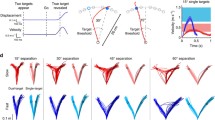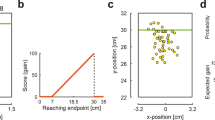Abstract
In motor tasks with explicit rewards and penalties, humans choose movement strategies that nearly maximize expected gain (Trommershäuser et al. in J Opt Soc Am A 20:1419–1433, 2003). Here, we examine whether performance is still close to optimal when information about payoffs is not available prior to movement onset. Subjects rapidly touched a target region while trying to avoid hitting an overlapping penalty region placed randomly to the left or right of the target. Subjects received rewards and incurred penalties for hitting the corresponding regions. Late responses (>700 ms) were heavily penalized. The penalty region was displayed 0, 200 or 400 ms after the reward region and the subject could not know where it would be until then. Reaction times to begin the movement after stimulus appearance were constant across conditions. Median reaction times were approximately 200 ms, i.e., the time the penalty was first displayed in the 200 ms delay condition. Performance was compared to that of an optimal movement planner that chooses mean end points to maximize expected gain despite movement variability. In the 0 and 200 ms delay conditions, subjects selected strategies that did not differ significantly from optimal, indicating that humans are able to plan their movements well despite delayed and unpredictable onset of information. Performance dropped below optimal in the 400 ms delay condition, with mean movement end points closer to the penalty region than predicted by the optimal strategy (in the high-penalty condition). We conclude that relevant information concerning the reward structure is required between 200 and 400 ms prior to the end of the movement, but can still be integrated into the movement plan after movement initiation.




Similar content being viewed by others
References
Brainard DH (1997) The psychophysical toolbox. Spat Vis 10:433–436
Brenner E, Smeets JB (2004) Colour vision can contribute to fast corrections of arm movements. Exp Brain Res 158:302–307
Bridgeman B, Lewis S, Heit G, Nagle M (1979) Relation between cognitive and motor-oriented systems of visual position perception. J Exp Psychol Hum Percept Perform 5:692–700
Castiello U (2001) The effects of abrupt onset of 2-D and 3-D distractors on prehension movements. Percept Psychophys 63:1014–1025
Connolly JD, Goodale MA (1999) The role of visual feedback of hand position in the control of manual prehension. Exp Brain Res 125:281–286
Desmurget M, Pélisson D, Rosetti Y, Prablanc C (1998) From eye to hand: planning goal-directed movements. Neurosci Biobehav Rev 22:761–788
Diedrichsen J, Werner S, Schmidt T, Trommershäuser J (2004) Immediate spatial distortions of pointing movements induced by visual landmarks. Percept Psychophys 66:89–103
Elliott D, Binsted G, Heath M (1999) The control of goal-directed limb movements: correcting errors in the trajectory. Hum Mov Sci 18:121–136
Glover S, Dixon P (2002) Dynamic effects of the Ebbinghaus illusion in grasping: support for a planning/control model of action. Percept Psychophys 64:266–278
Goodale M, Westwood DA (2004) An evolving view of duplex vision: separate but interacting cortical pathways for perception and action. Curr Opin Neurobiol 14:203–211
Hamilton AFC, Wolpert DM (2002) Controlling the statistics of action: obstacle avoidance. J Neurophysiol 87:2434–2440
Howard LA, Tipper SP (1997) Hand deviations away from visual cues: indirect evidence for inhibition. Exp Brain Res 113:144–152
Jeannerod M (1988) The neural and behavioral organization of goal-directed movements. Oxford University Press, Oxford
Keele SW, Posner M (1968) Processing of visual feedback in rapid movements. J Exp Psychol 77:155–158
Komilis E, Pélisson D, Prablanc C (1993) Error processing in pointing at randomly feedback-induced double step stimuli. J Mot Behav 25:299–308
Pélisson D, Prablanc C Goodale MA, Jeannerod M (1986) Visual control of reaching movements without vision of the limb. II. Evidence of fast unconscious processes correcting the trajectory of the hand to the final position of the double step stimulus. Exp Brain Res 62:303–311
Pelli DG (1997) The VideoToolbox software for visual psychophysics: transforming numbers into movies. Spat Vis 10:437–442
Rosenbaum DA, Loukopoulos LD, Meulenbrock RJ, Vaughan J, Engelbrecht SE (1995) Planning reaches by evaluating stored postures. Psychol Rev 102:28–67
Sabes PN, Jordan MI (1997) Obstacle avoidance and a perturbation sensitivity model for motor planning. J Neurosci 17:7119–7128
Sarlegna F, Blouin J, Bresciani JP, Bourdin C, Vercher JL, Gauthier GM (2004) Online control of the direction of rapid reaching movements. Exp Brain Res 157:468–471
Saunders JA, Knill DC (2004) Visual feedback control of hand movements. J Neurosci 24:3223–3243
Saunders JA, Knill DC (2005) Humans use continuous visual feedback from the hand to control both the direction and distance of pointing movements. Exp Brain Res 162:458–473
Schmidt T (2002) The finger in flight. Real time motor control by visually masked color stimuli. Psychol Sci 13:112–118
Tipper SP, Howard LA, Jackson SR (1997) Selective reaching to grasp: Evidence for distractor interference effects. Vis Cognition 4:1–38
Trommershäuser J, Maloney LT, Landy MS (2003a) Statistical decision theory and trade-offs in the control of motor response. Spat Vis 16:255–275
Trommershäuser J, Maloney LT, Landy MS (2003b) Statistical decision theory and the selection of rapid, goal-directed movements. J Opt Soc Am A 20:1419–1433
Trommershäuser J, Gepshtein S, Maloney LT, Landy MS, Banks M (2005) Optimal compensation for changes in task-relevant movement variability. J Neurosci 25:7169–7178
Woodworth RS (1899) The accuracy of voluntary movement. Psychol Rev Monographs 3:1–114
Acknowledgments
Supported by Grant EY08266 from the National Institute of Health; Deutsche Forschungsgemeinschaft (Grants TR 528/1-1; TR 528/1-2).
Author information
Authors and Affiliations
Corresponding author
Rights and permissions
About this article
Cite this article
Trommershäuser, J., Mattis, J., Maloney, L.T. et al. Limits to human movement planning with delayed and unpredictable onset of needed information. Exp Brain Res 175, 276–284 (2006). https://doi.org/10.1007/s00221-006-0546-z
Received:
Accepted:
Published:
Issue Date:
DOI: https://doi.org/10.1007/s00221-006-0546-z




